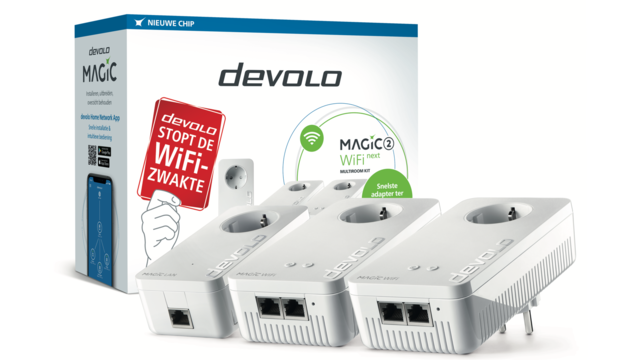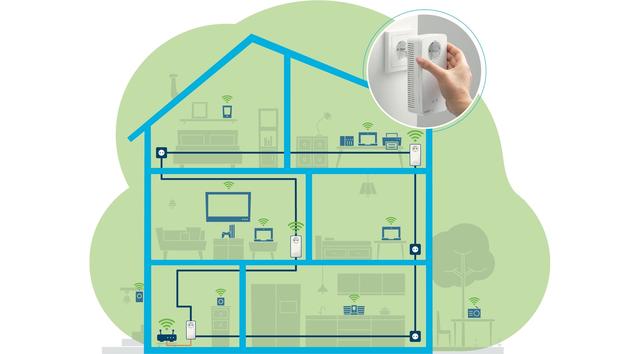
Devolo has a successor to its powerline and WiFi mesh network combination Magic 2 WiFi. The main novelty in the ‘next’ version is improved ‘multi-user mimo’ and the addition of ‘band steering’, two technologies that mainly improve video streaming and chatting. Does the new version perform as well or better than the previous one? We figured it out.
Devolo Magic 2 WiFi next Multiroom Kit
price € 257 (1 extra WiFi adapter: € 109)
Firmware versions tested magic-2-lan-7.8.5.61 (LAN); 5.6.0 (WiFi)
Technic HomeGrid Forum (HGF) G.hn; Powerline 1200/2400 / Wi-Fi 4/5
Wifi details 300 (2.4 GHz) + 867 (5 GHz) Mbit / s (AC1200)
Powerline details Powerline OFDM OFDM – 4096/1024/256/64-QAM, QPSK, BPSK (1200/2400 Mbits / s)
Connections 2 x gigabit ethernet lan; integrated power socket
Consumption 12.1 watts maximum and 8.9 watts average
Dimensions (W x H x D) 152 x 76 x 40 mm (Magic 2 next WiFi 2-1); 130 x 66 x 40 mm (Magic 2 next Lan 1-1)
Website www.devolo.nl
8 Score 80 
- Pros
- Safe
- Stable
- Negatives
- Size plugs
- Plugs get hot
We test the devolo Magic 2 WiFi next Multiroom Kit with three plugs, enough for a wireless network with a coverage of up to 180 square meters. The adapters are also available individually (for 90 square meters) or in pairs (‘Starter Kit’, sufficient for 120 square meters). The LAN adapter must of course be present, so at least you start with the starter kit, which you can then expand further to a maximum of eight separate WiFi adapters.
Externally, the glossy white plugs that have turned out quite strongly do not differ from the previous version. The multiroom kit contains two WiFi / powerline plugs (with four integrated antennas) and one (smaller) powerline plug, all with integrated socket. A good PLC connection is only guaranteed if you plug the devolo plugs directly into a wall socket. You then plug other equipment or a junction box into the built-in socket.

Technic
Just like the previous generation, the ‘next’ version combines Powerline G.hn with AC1200 mesh WiFi. The Wi-Fi speed remains the same, namely in theory a maximum of 300 Mbit / s in the 2.4 GHz and 867 Mbit / s in the 5 GHz frequencies. The power network speed is also the same: the plugs communicate with each other at a maximum of 2.4 Gbit / s over a three-core power cable. As prescribed by the G.hn standard, all network traffic is encrypted by default with 128-bit strong aes encryption. This encryption is done ‘peer to peer’ between each plug; each plug uses a unique encryption key that is not shared with any other plug in the same network.
The Wi-Fi plugs, in turn, support the newer and more secure wpa3 personal encryption, while also remaining compatible with the older wpa2 security standard.

AP control
Improved mu-mimo and the addition of ‘access point steering’ ensure a more efficient use of the wireless network. Client equipment automatically picks up the best Wi-Fi signal; multiple multimedia streams go to multiple devices without interference. With your wirelessly connected device, you can walk around freely within range of the WiFi network without interruptions during, for example, a Netflix stream or video chat.
However, how well this works also depends on the Wi-Fi chip in the device. The more recent its Wi-Fi chip, the greater the chance that everything will function flawlessly. (Technically, the client must support the Wi-Fi standards IEEE 802.11k (automatic discovery of the best AP) and 802.11v (automatic exchange of information about the quality of the wireless signal)).
Note: This automatic wireless signal targeting will only work if the ap’s 5GHz frequency is enabled and the SSID and security settings are identical to the 2.4GHz signal. By the way, this is the standard configuration of the devolo Magic 2 next kit.
Installation
The installation procedure is identical to that of the previous version. In short, it comes down to activating the plugs in sequence, waiting for them to make a PLC connection with each other, connecting the LAN adapter to your internet modem or router using the included network cable and then further refining the configuration if necessary. with the devolo Home Network app or Cockpit software, although the latter is not really necessary, because in principle the kit works perfectly straight out of the box.
If desired, you can copy the data of the existing WiFi network from your existing router to the devolo kit so that everything uses the same password and the same network name. This can be done at the touch of a button (wps function), or with the help of the app. If the automatic configuration does not succeed, you can also set up the connection manually. How to do this is explained on page 41 of the installation guide, which is also in Dutch.
We rate the installation procedure as very user-friendly.

Practice
The latest version of the devolo app is more streamlined than the original. Advanced options can be accessed directly in the app and are no longer accessed via a web interface. Advanced options such as VPN, parental control and firewall protection can be arranged on your existing router or modem. Magic 2 next functions itself purely as a network extension and relies on the connected network router or internet modem for all settings.
The plugs get pretty hot at the back (the side that is connected to the socket). You can check the temperature in the app. During our test, those reported temperatures up to 60 ° C for the Wi-Fi and up to 80 ° C for the LAN plugs. This at an ambient temperature in the test room of 22 ° C.
Performance
In our usual extensive iperf3 benchmark, which we run on various devices and with various settings in a realistic environment with neighboring WiFi signals, the devolo Magic 2 next is on average over 23 percent faster than the previous version. Depending on the location, we note realistic wireless throughput rates between 129 Mbit / s and 384 Mbit / s. The average real wireless network speed of all test locations is 235 Mbit / s.
But an average does not say everything. We test in a large house on different floors. The devolo Magic 2 next delivers approximately the same throughput speed in the iperf3 benchmark on every floor.
Conclusion
Devolo Magic 2 next performs even better than the previous version. It works especially well in buildings where a regular Wi-Fi signal is too weak to get past concrete walls and ceilings. Or in locations that are too far from a Wi-Fi router or access point. The powerline technology ensures stable connections via the electricity grid between self-configuring WiFi access points and the central router or modem. Once installed and configured, you no longer have to worry about the Magic 2 next.
.